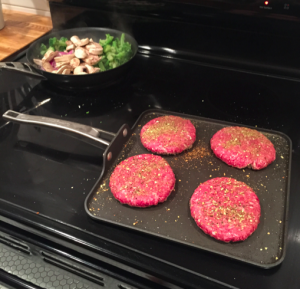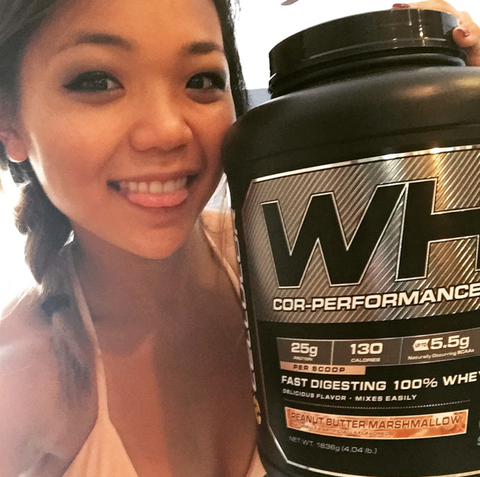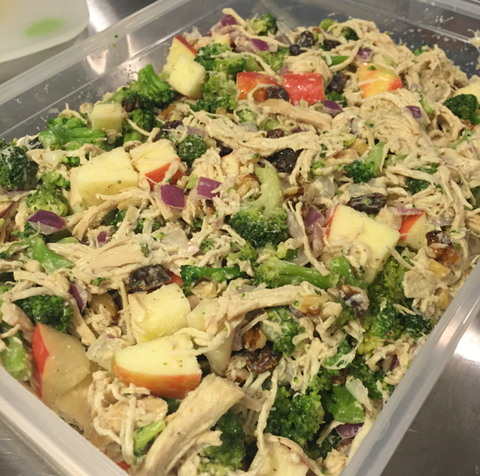How to Get More Protein in Your Diet
Getting in more protein is a recurring issue I run into with my clients, particularly ones who are newer to the fitness game. And understandably so – carbohydrate- and fat-heavy foods tend to be far more palatable, and I really don’t know of many, if any, individuals who have woken up in the middle of the night craving a thick slab of grilled chicken breast.
Still, dietary protein is a critical component of not only your physique but also your overall physical health, so it’s important that you’re taking steps to ensure that you’re consuming enough.
Let me walk you through how you can get more protein in your diet.
What is dietary protein?
What’s all the hype about protein, anyway? Isn’t it really only for hardcore bodybuilders who are looking to get jacked out of their minds?
Actually, we all need it.
Going back to the basics, protein is one of the three macronutrients, next to carbohydrates and fats. Proteins are made up of amino acids and constitute the building blocks of skeletal muscle. For athletes and other active individuals, this macronutrient is crucial to help rebuild and repair skeletal muscle before and after an intense bout of exercise.
Here’s a rudimentary list to give you an idea of what protein sources look like in whole foods:
Egg whites
Whole eggs
Greek yogurt
Chicken breast
Turkey breast
Pork tenderloin
Canned tuna
Cottage cheese
Milk
Extra lean ground beef
Top round steak
Top sirloin steak
Flank steak
White fish (cod, halibut, haddock, mahi mahi, tilapia, etc.)
Salmon
Protein powder
Quest bars
Are all proteins created equal?
Not at all, actually. Proteins differ not only in their quality but also in their source and digestion rate.
There are 20 total amino acids, nine of which are considered essential amino acids (EAAs), meaning that they cannot be produced in the body and must be obtained via diet. While there are a number of different methods to determine protein quality, typically the higher the EAA content of a protein, the better the quality (Lemon, 2000).
Of the nine EAAs, the three branched chain amino acids (BCAAs) are leucine, isoleucine, and valine. These three are unique, as they play special roles in neural function (Blomstrand, 2006), protein metabolism (Norton & Layman, 2006), and blood glucose and insulin regulation (Brosnan & Brosnan, 2006). Leucine is particularly special in that 2-3g of leucine alone has been found to stimulate protein synthesis independently (Layman, 2002).
Meat- and dairy-based proteins, such as steak, milk, and whey all contain high concentrations of leucine and are therefore considered higher quality proteins (Norton & Wilson, 2009). Plant-based proteins, on the other hand, often lack sufficient EAAs to be considered a complete protein source (Campbell et al., 1999). As a staunch omnivore, I’m admittedly not well-versed with vegetarian or vegan diets, so here’s a solid post from Greatist taking you through some complete plant-based protein sources you may not know about.
How much do I need?
Protein needs vary based on the individual.
Before we move forward, one thing is abundantly clear: the Recommended Daily Allowance (RDA) for protein set by the US government is not nearly enough for healthy, active folks like you and me. Keep in mind that the current RDA of 0.8g/1kg total bodyweight is actually set for sedentary persons. When you add resistance training to the mix, everything changes.
For most active individuals, somewhere within the range of 0.6-1.0g protein per 1lb total bodyweight per day is solid, with approximately 30g consumed per meal for satiety and optimal muscle protein synthesis (Layman, 2009). It doesn’t hurt to go above that, either, particularly if you’re in a steep caloric deficit and your bodyfat is already low. As well, more protein can help preserve, and sometimes even add, muscle mass when dieting.
Check out our Physique Science Podcast hosted by myself and Dr. Layne Norton as we interview Dr. Stu Phillips on dietary protein:
As well as our interview with Dr. Don Layman on leucine:
How do I get more protein in my diet?
Ah, finally. Now that we know how much protein you should be shooting for, how the heck do you get there?
Aim for around 30 grams of protein per meal.
For practical purposes, breaking down your protein goal meal-by-meal is a lot less daunting than trying to shoot for a daily total without a plan for how to get there. Striving for 30g per meal is very reasonable and can be accomplished with the following:
45g most protein powders
100g chicken breast
100g pork tenderloin
150g 93/7 ground beef
9 egg whites
5 eggs
That’s just a starting point to give you an idea of how much protein is in different food sources.
If you don’t have a food scale (and I highly recommend you get your hands on one), you can eyeball your portion sizes. In general, go for protein around the size of your palm and you should be fine.
Oh, and yes, trace protein counts, too. An ounce of cheddar cheese, for example, has 6g protein, 1g carb, and 9g fats — so those 6g would absolutely get added to your total.
Make protein the center of (almost) every meal.
This means that having mac and cheese for dinner is probably okay on occasion, but make sure you add in some protein as well. May I suggest some ham, or perhaps some diced chicken breast?
Oh, what’s that? You want to have a quesadilla? Sweet – just make sure you throw some meat in there.
Whenever I eat something, I pretty much always try to pair it with a protein source as well. If I’m going to have an apple, for example, maybe I’ll have a protein bar or a protein shake with it. I just took that from an all-carbohydrate snack to a protein-and-carb meal. Easy.
When I go out to eat, rather than thinking, “What looks tasty?” I’m wondering, “What has ample protein and mostly whole foods and looks delicious?” Oftentimes for me, that ends up being a giant chicken or steak salad with fun toppings (dressing on the side!), seared tuna, or salmon. That subtle shift in mindset can be a true nutrition game changer.
Work on making this the norm. The default, over time, should be to put protein first.

If you’ve already hit your target protein intake for the day, then of course a non protein-centric meal is perfectly fine at that point to help round out the rest of your macronutrient numbers. But this is only if you’ve met your intake.
Keep more protein around the house.
You’re going to eat what you have access to – and conversely, you’re not going to eat what’s not available. Seems like a no-brainer, right? Yet you’d be surprised at how many people claim to be trying to consume more protein yet don’t take measures to keep more protein around at home.
At the very least, I recommend having some high quality deli meat in your fridge as well as some tuna cans in your pantry. Oh, and some protein powder. It can’t hurt.
Ninety-nine out of a hundred times, you probably won’t need that emergency tuna. But one day when you find yourself in a bind, you’ll be glad you kept it around.
Increase your protein intake slowly.
This is an important point for those of you whose current protein intake is far below your goal intake. Trying to consume 80g more protein overnight and then sustain that over the long haul is a lofty endeavor and likely won’t shake out too well. It’s really not enjoyable and you may find yourself constipated – and we don’t want that, now, do we?
Instead, shoot for a 20-30g bump per week. This is far more attainable. You can do this by simply adding in 5g protein per meal or tossing in an extra meal or protein shake into your day. Continue increasing your intake on a weekly basis until you’ve reached your target number. This may take a few weeks or maybe even a few months – that’s completely okay.
Supplement with a protein shake.
I keep a few tubs of whey protein around for those times when I want a quick pulse of protein and don’t want to take the time to whip up a meal.
While there’s nothing inherently magical about whey protein, it’s a great option for when you’re short on time or on the run. Just add water. Convenience at its best!
I’ll usually blend some protein powder with milk and a banana after a training session for quick digestion, though when it’s hot out, I’ve been known to blend some chocolate whey with iced coffee to create a faux frappuccino. Mmm mmm tasty.
My favorite brand is Cellucor in the molten chocolate and peanut butter marshmallow flavors. With 25g protein per scoop, it tastes great and mixes well with other ingredients.

Protein recipes
Here are some recipes I’ve collected for you to help you get started. These ones are simple to make and you don’t need to be a fancy chef to whip these up by any means.
I strongly recommend that you make multiple batches when cooking. This will not only save you time, but will make meal prepping easier by a thousandfold without adding much work. I’ve been known to double or even triple recipes, and doing so will last me the whole week.
When it comes to diving up recipes, don’t stress over exactly even measurements. I promise you it’s not worth the stress and won’t even matter in the long haul. Measure out all the ingredients for the entire recipe, put it all together, and then split it into roughly equal servings – and let that be good enough.
Betsy’s Peanut Butter Pretzel Pancake
Betsy Welch is a long-term client of mine who is not only strong as hell in the gym but also a genius in the kitchen. Her Instagram is chock-full of protein pancake recipes, and if you like this one below, you should pick up a copy of her protein pancake e-book here.

What You’ll Need
Batter:
30g Quest Nutrition peanut butter protein powder
15g coconut flour
46g egg white
120g unsweetened vanilla almond milk
3/4 tsp baking powder
Filling:
3g sugar-free vanilla jello pudding mix
33g fat-free cream cheese
20mL unsweetened vanilla almond milk
6g PB2 powder
Topping:
18g fat-free Cool Whip
12g PB2 powder mixed with water
15g pretzels
Directions
Mix all batter ingredients in a bowl and allow to sit for 5-7 minutes while coconut flour absorbs moisture.
Heat skillet on medium. Once heated, reduced to medium-low heat and spray pan with oil.
While pancakes are cooking, mix together cream cheese (melted), pudding mix, almond milk, and PB2 for filling in a small bowl.
Once pancakes have cooled, spread filling on top of each pancake before stacking.
Top pancake stack with Cool Whip, then drizzle on PB2 powder mixed with water, and finish off with pretzels.
Makes 1 serving
Nutrition Information Per Serving
435 Calories
44g protein
45g carbs
8g fats
Sohee’s Chicken Apple Salad
I actually came up with this dish just last week. I was on the hunt for a protein-heavy dish that was simple to make, and I remembered when my best friend Marci sent me a recipe for this chicken apple salad recipe back in the spring.
I’ve tweaked that recipe a good bit – substituted some ingredients for others and added some tidbits – to make the macros a little more to my liking. I was surprised at how easy this was to make and have since re-created it four different times. Friends and family alike have given this one a thumbs up.

What You’ll Need
400g cooked chicken breast (I recommend cooking these in the slow cooker for easier shredding)
1 medium diced apple (I use honey crisp)
2 cups broccoli
40g raisins
40g walnut pieces
1/4 cup diced red onion
5.3oz Greek yogurt (I use Chobani plain)
2tbsp dijon mustard
Stevia to taste
Directions
1. Shred chicken breast in large bowl.
2. Mix together broccoli, raisins, walnut pieces, and red onions with chicken.
3. Stir in Greek yogurt, dijon mustard, and Stevia, and mix well.
4. Portion into roughly four equal containers.
5. Refrigerator for a few hours or overnight.
Makes 4 servings
Nutrition Information Per Serving
272 Calories
36.3g protein
20.1g carbs
5.4g fats
So here you have a number of concrete tools to help you on your quest to consuming more protein.
To learn more about how to count macronutrient numbers and adhere to them to reach your fitness goals all while incorporating your favorite foods into your diet, pick up a copy of my e-book, The Beginner’s Guide to Macros, and be sure to join the accompanying Facebook support group that comes with your purchase.

References
Blomstrand, E. (2006). A role for branched-chain amino acids in reducing central fatigue. J Nutr., 136(2):544S-47.
Brosnan, J.T., & Brosnan, M.E. (2006). Branched-chain amino acids: enzyme and substrate regulation. J Nutr., 136(1 Suppl):207S-11.
Campbell, W.W., Barton, M.L., Jr., Cyr-Campbell. D., et al. (1999). Effects of an omnivorous diet compared with a lactoovovegetarian diet on resistance-training-induced changes in body composition and skeletal muscle in older men. Amer J Clin Nutr., 70(6):1032-9.
Layman, D.K., (2002). Role of leucine in protein metabolism during exercise and recovery. Can J Appl Phys., 27(6):646-63.
Layman, D.K. (2009). Dietary Guidelines should reflect new understandings about adult protein needs. Nutr & Metab, 6:12.
Layman, D.K., & Walker, D.A. (2006). Potential importance of leucine in treatment of obesity and the metabolic syndrome. J Nutr., 135(1 Suppl):319S-23.
Lemon, P.W. (2000). Beyond the zone: protein needs of active individuals. J Am Coll Nutr., 19(5 Suppl):513S-21.
Norton, L.E., & Layman D.K. (2006). Leucine regulates translation initiation of protein synthesis in skeletal muscle after exercise. J Nutr., 136(2):533S-37.
Norton, L.E., & Wilson, G.J. (2009). Optimal protein intake to maximize muscle protein synthesis. AgroFood Industry Hi-Tech, 20:54-7.
Phillips, S.M., & Van Loon, L.J. (2011). Dietary protein for athletes: from requirements to optimum adaptation. J Sports Sci., 29(1):S29-38.




